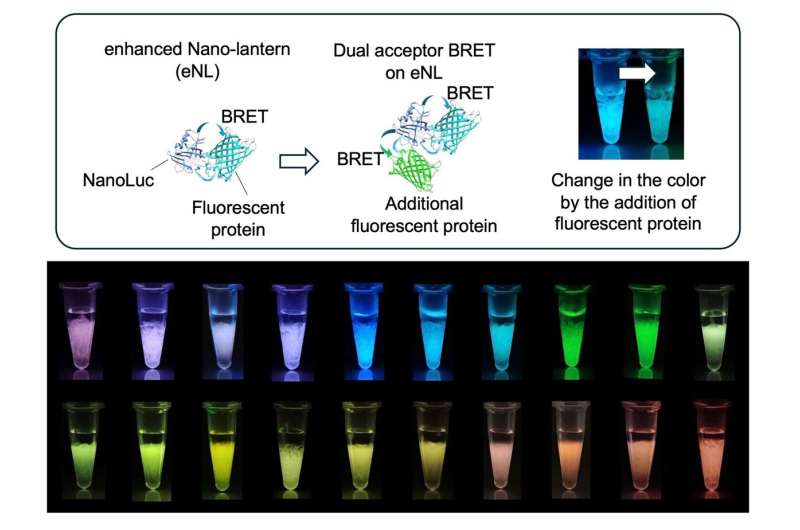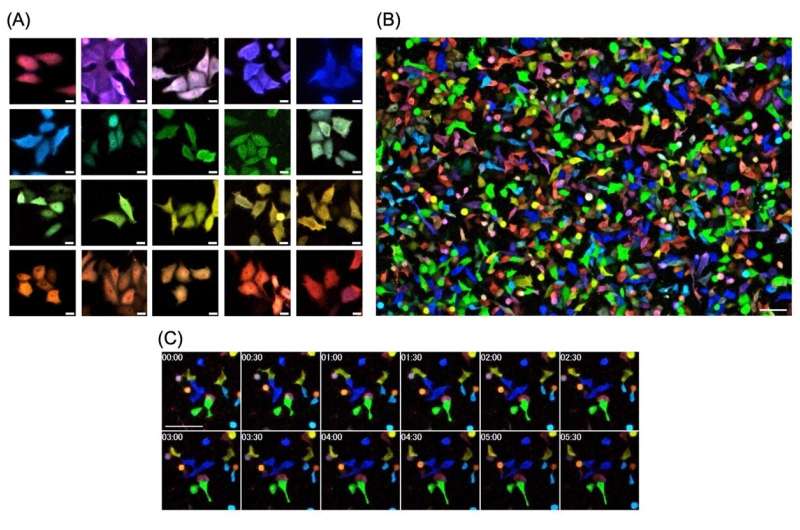This article has been reviewed according to Science X's editorial process and policies. Editors have highlighted the following attributes while ensuring the content's credibility:
fact-checked
peer-reviewed publication
trusted source
proofread
Bioluminescent cell imaging upgrade makes it easier to track many targets simultaneously

Imaging live cells with fluorescent proteins has long been a crucial technique for understanding cellular behavior. While bioluminescent proteins offer several advantages over fluorescent proteins, the limited availability of color variants has made it difficult to observe multiple targets simultaneously.
Now, researchers from SANKEN (The Institute of Scientific and Industrial Research) at Osaka University have developed a method to expand the color palette of bioluminescent protein to 20 distinct colors, enabling advanced simultaneous multi-color imaging.
The research is published in the journal Science Advances.
Cells are the fundamental building blocks of life. Understanding how they function is essential for progress in biological sciences, medicine, and drug discovery.
Optical labeling techniques allow scientists to observe cell behavior, track cell fate, and identify cells with specific traits. While fluorescent proteins are widely used for these purposes, bioluminescent proteins are gaining popularity due to their unique advantages.
Bioluminescence, the natural emission of light by living organisms, is powered by a chemical reaction catalyzed by an enzyme, typically a luciferase, acting on a bioluminescent substrate.
Unlike fluorescent proteins, bioluminescent proteins do not require external light for excitation, avoiding issues like phototoxicity and background light. However, their use has been limited by the small number of available colors. Having distinct and easily distinguishable colors is vital for tracking multiple targets simultaneously.
Previously, a five-color series of bioluminescent labels was created by coupling one of the brightest luciferases, NanoLuc, with a fluorescent protein. This technique leverages the transfer of excited-state energy from the substrate to the fluorescent protein, altering the bioluminescence color.
While effective, this five-color palette was insufficient for more complex imaging needs. The researchers at Osaka University have now addressed this challenge by expanding the bioluminescent color palette to 20, making a significant leap forward in multi-color imaging technology.

"Instead of fusing NanoLuc with a single fluorescent protein, we fused it with two," says lead author Mitsuru Hattori. "This approach allowed us to access a much broader range of bioluminescence colors by fine-tuning the combinations of fluorescent proteins."
The researchers achieved a remarkable milestone with their new bioluminescent protein labels. They captured a single-shot image of a mixture of cells expressing all 20 bioluminescent proteins, used the labels to visualize distinct subcellular components, and even demonstrated their capability in live mice.
Additionally, they successfully conducted time-lapse observations of cell behavior over several hours, simultaneously tracking seven distinct labels.
"What's truly exciting is that we could detect all 20 colors simultaneously without any time lag, using a standard smartphone camera," explains senior author Takeharu Nagai. "This innovation makes it significantly easier and more cost-effective to monitor multiple targets or track individual cells within a population."
These newly developed bioluminescent colors have the potential to revolutionize cell fate tracking, offering insights concerning how cells develop into specific cell types and identifying cells with unique responses to drugs.
The team's breakthrough in bioluminescent imaging opens new doors for advancements in biological research, drug discovery, and medical science.
More information: Mitsuru Hattori et al, Creating coveted bioluminescence colors for simultaneous multi-color bioimaging, Science Advances (2025). DOI: 10.1126/sciadv.adp4750. www.science.org/doi/10.1126/sciadv.adp4750
Journal information: Science Advances
Provided by Osaka University




















